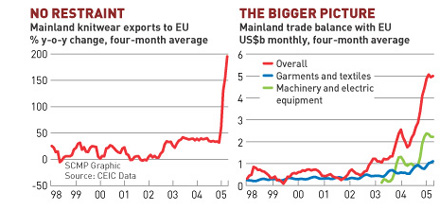|
| ||
|
← "The Singaporification of Hong Kong" |
Return to Main Page
| "Top referrers and stats for May" →
| TrackBack (1)
June 01, 2005
You are on the invidual archive page of To catch a liar. Click Simon World weblog for the main page.
|
|
To catch a liar
Tim Worstall caught out the EU in a lie over stats related to the looming textile quotas on China. Today Jake van der Kamp in the SCMP follows through with the next part of the lie.
Quota restrictions on garment exports, which were imposed by the developed world on developing countries 30 years ago as a route (supposedly) to gradual adoption of worldwide free trade in garments and textiles, were finally abolished on January 1.That's right. America and Europe have had decades to prepare for this liberalisation of trade. Decades. ...mainland knitwear exports to the EU account for only 0.2 per cent of the EU's imports and we are talking here of EU imports after eliminating trade between EU countries. Of course, knitwear exports also account for barely 25 per cent of the mainland's exports of garments and textiles to the EU. They are the most egregious examples of the garment export boom to the EU.I wonder if the numbers are the same for the US? I imagine they are. You see, even the EU and USA believe in the bogeyman...even if he doesn't really exist. posted by Simon on 06.01.05 at 10:57 AM in the
Trackbacks:
TrackBack URL for this entry: http://blog.mu.nu/cgi/trackback.cgi/83745 Send a manual trackback ping to this post. Those Textile Quotas. Excerpt: Following on from my angry snarling about the EU’s likely re-imposition of quotas on Chinese textile imports and the lies being told to support such, Simon’s World has an interesting piece from the South China Morning Post. It would appear Weblog: Tim Worstall Tracked: June 1, 2005 04:17 PM
Comments:
Why don't we hear anything from organizations supposed to defend consumer interests? Consumer interests are hurt here by the lies of our European leaders. posted by: ivan on 06.01.05 at 04:59 PM [permalink]It's pretty simple. The interests of consumers are diverse and the price improvements (relatively) small - the benefits are difuse. On the flipside the costs are concerntrated and have a large impact (loss of job, bankruptcy). So naturally the small special interests make a huge amount of noise. It's a variation on the tragedy of the commons. You're right - the answer is to get consumers to band together to overcome the special interests...but that's true in far more situations than just this. posted by: Simon on 06.01.05 at 05:09 PM [permalink] |
|
